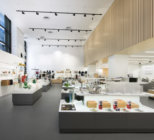With its origins down the road at The Pearoom in Heckington, which was built in 1870 to store peas, and converted into a heritage, craft and tourism centre for the village in the 1970s, the National Centre for Craft and Design (NCCD) balances the fine art of keeping locals happy while also impressing visitors from further afield.
Moving to a converted seed warehouse in Sleaford in 2002 the centre was quickly recognised as a nationally significant development by Arts Council England and was re-branded as The National Centre for Craft & Design in 2011. With five gallery spaces it showcases up to 20 world-class exhibitions every year from the most innovative, challenging and accomplished artists to new and emerging talent.
Faye Parker NCCD’s Craft & Design Officer who runs the shop and sources all of the products has been with the centre for six years and says she has endeavoured to make it more approachable and accessible for visitors as well as a shop window for local makers.
When she arrived at the shop she says it looked more like an exhibition space, with a lot of plinths and each maker being confined to just one. Visitors were confused as to whether it was a continuation of the galleries or a shop where they could buy the products.
“So I began to make the space look and feel more like a shop and give it a personality,” she says. “This has meant that the makers we work with have evolved with the space and a lot of this has been achieved through visitor feedback.”
Parker, who works alongside two other colleagues, says their quest is to introduce visitors to products that are unique to NCCD that they won’t have seen in the surrounding area. In doing so they make local makers the foundation of the shop and have strong relationships with a number of craft and design experts, some of whom they have been working with since the building was opened.

“We work very closely with Kate Mcbride, Karen Atherley and Angela Ibbs,” she says. “People are surprised that these artists are from or work from Sleaford.”
Retail in museums is important, Parker says, because it’s an opportunity for visitors to take something away that represents the exhibitions they have seen but cannot touch or buy.
“In the museum shop you can interact with objects and pick up a piece of ceramic and see that it is handmade and that it required great skill to make. People understand that and appreciate that. From the feedback I get a lot of people buy objects as gifts as they’re something special that they’ve never seen anywhere else. The fact that we have the branding of the National Centre gives it provenance. We also have branded bags and make information cards about our products so we go that extra mile. The visitor gets to know who the product has been made by and how it’s been made.”

Parker says it is integral that when she plans the shop’s displays and commissions stock it always links back to what is happening in the galleries. This means always monitoring what exhibitions are coming up. For example this autumn and winter she is focusing on Laura Ellen Bacon’s Rooted in Instinct exhibition, which opens next month and will see the shop take on a rustic aesthetic feel for Christmas.
“We always draw inspiration from the gallery but we still give the shop its own identity but it affects what products we get in. So I will be looking at the use of natural materials, gift items, and a range of books connected to the exhibition and makers, which sell well because the visitors are interested in these products through their interest in the exhibition. We get a lot of comments when it all flows, as visitors find it more engaging.”
The shop also extends the museum’s ethos of getting people creative and if there is a print-making workshop being organised then Parker and her team will order lino and other material that participants will want to buy to create their own works.
In terms of the stock and resources, the shop team has expanded the jewellery offer that it provides and has also introduced an art materials area (the only place that does that in the area), a book area, which sells niche magazines and a small print shop.

Because the main focus of the NCCD’s shop is selling makers’ work and because it is a manageable size Parker and her team can make all the orders, monitor the stock, listen to visitors’ feedback and ask them what they want to see in the shop and rejig it accordingly. “We aim to engage with visitors and giving them a better understanding of a variety of crafts. We have a sister organisation Design Factory and Design Nation, which are located in the building and they have emerging artists that we help mentor and take to trade shows and also offer them a shop window to start selling their work. We also support the established artists and we try and introduce people to these makers.”
An example of this is designer Angela Ibbs’s Gifted exhibition in 2015 for a Makers’ Fair at the centre, which was complimented with a display in the shop’s window space. The display featured her wall mosaics working up the staircase from the shop into the gallery spaces and Parker says visitors appreciated seeing her smaller pieces in the shop as well as a wider range of her work in the gallery.

“Whenever there is a new gallery exhibition I usually contact the makers and sometimes they will have a book they are featured in or smaller objects that we can sell and again the customers can see the exhibition and buy something related to it.” In 2015 visual artist Michael Brennand-Wood held a solo exhibition in the main gallery called Seeds of Memory, which was a collection of large scale embroideries of which he made smaller scale brooches that were sold in the shop.
The current The World is Your Dressing Up Box exhibition, which showcases fashion and its makers, has led the shop to create its own display of fashion jewellery, which has been extremely popular.


Parker says the shop will continue to show new products and keep ahead of the trend by constantly keeping up to date with what ranges the makers are working on. “I want to step away from this idea that craft and design is stuck in the past and feel we are breaking the mould a little.”
The shop is not exclusive to makers, however, and is open to local people coming into the centre to look around. Many of them, says Parker, come to pick up the shop’s unique craft greeting cards and this gives the staff the chance to explain what the centre is all about and promote exhibitions and workshops.
Sales figures have increased year-on-year and Parker is always looking at more ways to improve that, which has included setting up an Instagram account where she can post the latest products online. In the future the shop will look at developing a dedicated online shop but for now it is focusing on its very personal method of retail that offers a unique window to the world of craft and design.









